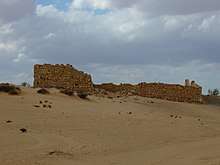Haluza
| חלוצה - الخلصة | |
 | |
 Shown within Israel | |
| Alternative name |
Halasa Chellous al-Khalasa Elusa |
|---|---|
| Location | Southern District, Israel |
| Region | Negev |
| Coordinates | 31°05′49″N 34°39′07″E / 31.097°N 34.652°ECoordinates: 31°05′49″N 34°39′07″E / 31.097°N 34.652°E |
| Type | Settlement |
| History | |
| Cultures | Nabataean, Roman |
| Site notes | |
| Condition | In ruins |
| Official name | Incense Route - Desert Cities in the Negev (Haluza, Mamshit, Avdat and Shivta) |
| Type | Cultural |
| Criteria | iii, v |
| Designated | 2005 (29th session) |
| Reference no. | 1107 |
| State Party | Israel |
| Region | Europe and North America |
Haluza (Arabic: الخلصة; Hebrew: חלוצה), also known as Halasa, Chellous (Χελλοὺς in Greek, although in the 6th-century Madaba Map the town appears as ΕΛΟΥϹΑ), Elusa, al-Khalasa and al-Khalūṣ (Arabic), is a city in the Negev, Israel, that was once part of the Nabataean Incense Route. Due to its historic importance, UNESCO declared Haluza a World Heritage Site along with Mamshit, Avdat and Shivta. The city is one of the two main potential locations for the Biblical city of Ziklag,[1] Ziklag being considered in this case a corruption of Halusah, meaning fortress.[1] In Saadia Gaon's Judeo-Arabic translation of the Pentateuch, the biblical town of Gerar is associated with Haluza (Judeo-Arabic: 'אלכ'לוץ = al-Khalūṣ).[2]
History
The city is mentioned under the name 'Chellous' (Χελλοὺς) in the Greek text of Judith, i, 9. It is also mentioned by Ptolemy[3] as being in Idumaea, Peutinger's Table, Stephanus Byzantius (as being formerly in the province of Arabia Petraea, now in Palaestina Tertia), Jerome,[4] the pilgrim Theodosius, Antoninus of Piacenza, and Joannes Moschus.[5]
Jerome's life of St. Hilarion says that, in the fourth century, there was at Elusa a great temple of Aphrodite.[6] Hilarion is supposed to have introduced Christianity to Elusa in the fourth century.[7]
Early in the following century, a Bishop of Elusa, after redeeming the son of Nilus of Sinai, who had been carried off from Mount Sinai by the Arabs, ordained both him and his father.[8] Other bishops known are Theodulus, 431; Aretas, 451; Peter, 518; and Zenobius, 536.[9]
The ruins of the city are at al-Khalasa (Khalasah), about nineteen miles southwest of Beersheba, in a large plain within modern Israel. Many inscriptions have been found there.[10] In the vicinity, according to the Targums, was the desert of Sur with the well at which the angel found Hagar (Genesis 16:7). (See Revue Biblique, 1906, 597).
Archaeological surveys of the area are partly hampered by the presence of shifting sands around the city, though Nabataean era streets have been found, along with two churches, a theatre, winepress, and tower.[11] Unlike the other cities on the Incense route, Haluza has been excavated without sufficient care to return stones to their original places, compromising future excavation, and the site is generally badly looked after.[11][12]
The bishopric of Elusa is included in the Catholic Church's list of titular sees.[13]
See also
References
- 1 2 Jewish Encyclopedia; Easton's Bible Dictionary; Cheyne and Black, Encyclopedia Biblica
- ↑ Rabbi Saadia Gaon's Judeo-Arabic Translation of the Pentateuch (Tafsir), s.v. Genesis 10:19, Genesis 20:2, Genesis 26:17, 20. On Haluza's proximity to Gerar, see: M. Naor, Gerar — Tell el Far'a, Bulletin of the Israel Exploration Society (1955), pp. 99–102 (Hebrew)
- ↑ V:xv:10
- ↑ In Isaiam V:xv, 4
- ↑ Pratum Spirituale, clxiv
- ↑ "Vita Sancti Hilarionis", 25, in Patrologia Latina, XXIII, col.41
- ↑ Jerome, loc.cit.
- ↑ Patrologia Graeca LXXIX:373-93
- ↑ Lequien, Oriens Christianus III, 735
- ↑ Revue Biblique, 1905, 246-48, 253-55
- 1 2 The Incense Route (Israel) UNESCO
- ↑ Benjamin Adam Saidel and Gary L. Christopherson, Palestine Exploration Quarterly, 137, 1 (2005), 53-63.
- ↑ Annuario Pontificio 2013 (Libreria Editrice Vaticana, 2013, ISBN 978-88-209-9070-1), p. 888
External links
- Incense Route - Desert Cities in the Negev UNESCO
- The Madaba Mosaic Map - Discussion 109. Elusa - (al Khalasa)
- Stops on the Incense Road - Elusa

![]()